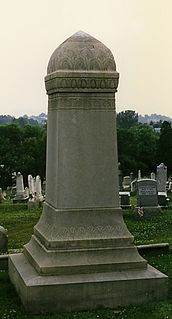 W
WPhallic architecture consciously or unconsciously creates a symbolic representation of the human penis. Buildings intentionally or unintentionally resembling the human penis are a source of amusement to locals and tourists in various places around the world. Deliberate phallic imagery is found in ancient cultures and in the links to ancient cultures found in traditional artifacts.
 W
WThe Chao Mae Tuptim shrine is a phallic shrine in Bangkok, Thailand, located behind the Swissôtel Bangkok hotel near the bank of the Khlong Saen Saep. The shrine was created in the first quarter of the 20th century by Thai businessman Nai Lert (1872-1945), who found a spirit house floating in the klong and placed it on the bank of his property. In Thailand, the phallus is considered to be a symbol of good luck and also a representative of fertility. The shrine is one of the best examples of intentional phallic architecture in the world. The site, which measures roughly 60 by 70 feet, is now "crammed with carved" wooden circumcised penis statues, which are said to possess special cosmic powers and endow good fortune and fertility on anybody coming into contact with them. The size of the penis statues, which number well over 100, is said to range "[from] the size of a cream doughnut to the size of a canoe"; some are huge, some are humorous and painted pink to closely resemble a human phallus.
 W
WColonna Mediterranea, commonly known as The Luqa Monument is a 21st-century landmark obelisk in Luqa, Malta. The abstract art has created local and international controversy over its phallic appearance.
 W
WHaesindang Park, also called Penis Park, is a park located on the east coast of South Korea, in a city called Samcheok, about 20 kilometres (12 mi) south of Samcheok in Gangwon Province. The park is noted for its number of phallic statues. The collection created by Korean artists is on display in the form of "hanging arrangements to three-meter tall trunks of wood", for joy, spirituality and sexuality. A small Folk Museum titled "Village Folk Museum" has exhibits of art objects on the "sex iconography" over ages in different cultures, shamanic rituals and also the history of the Korean fishing community.
 W
WKhalid Nabi Cemetery is a cemetery in northeastern Iran's Golestan province near the border with Turkmenistan, roughly 60 kilometres (40 mi) northeast of Gonbad-e Kavous city, in the Gokcheh Dagh hills of Turkmen Sahra. It is mainly situated on a mountain ridge about 1 km distance from the mausoleum called “Khaled Nabi” who according to oral tradition of the Yomut Turkomans was a pre-Islamic prophet and whose mausoleum is visited by them for pilgrimage together with the neighbouring one of Ata Chofun, his son-in-law.
 W
WKharkhorin Rock, also Kharkarin Rock or Phallic Rock, is a large statue of a penis raised on a platform on the steppe, located near Erdene Zuu Monastery in Kharkhorin, Övörkhangai Province of Mongolia. The phallic rock statue has dual functions; primarily it is a reminder to the monks to remain celibate, but it is also a symbol of fertility and human life. The newer, five metre tall stone statue also pictured on this page is incorrectly referenced as also being located near Kharkhorin, however, its location is noted by some as not being near the former capital city Kharkhorin, but near the smaller town of Khankhongor, much further south, in a different region. In fact, very few travel sites and blogs by frequent visitors to Kharkhorin report seeing this larger statue near the monastery. However it was removed soon after due to local people's heavy discontent
 W
WKolonna Eterna, also known as the Millennium Monument, is a 21st-century monumental column in San Gwann, Malta. The column is an abstract art designed by Paul Vella Critien, a Maltese local artist that achieved his studies and experience in Italy and Australia.
 W
WA puer mingēns is a figure in a work of art depicted as a prepubescent boy in the act of urinating, either actual or simulated. The puer mingens could represent anything from whimsy and boyish innocence to erotic symbols of virility and masculine bravado.